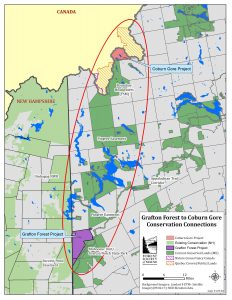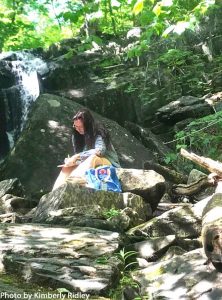
Have you ever experienced the solitude of hiking for miles without seeing any buildings? On the other hand, have you ever watched wildlife try to cross a busy road? Experiences like this highlight how meaningful an interconnected landscape is for people and animals. That’s why the Forest Society of Maine (FSM) is thrilled to announce that two of our newest conservation projects in western Maine add to a continuous corridor of conserved land stretching across the western edge of Maine from New Hampshire to Canada. The Grafton Forest project and Coburn Gore Forest project encompass working forestlands that provide employment and raw materials for a variety of workers and businesses. Connected landscapes benefit forest management, enhance wildlife habitat, and provide resilience in the face of climate change.
Coburn Gore Forest Project
The 8,300-acre project area in Coburn Gore Township has been owned by the same family for decades. It boasts an exceptionally well-managed forest. The lands encompass the headwaters of the Dead River and Kennebec River; a grove of old growth trees, a unique bog ecosystem, and two state-designated Heritage brook trout ponds. Lands to the west and north of the Coburn Gore property, in Québec, are conserved provincial forest and recreation lands. To the south is the Boundary Headwaters Conservation Easement, conserved by FSM more than a decade ago.

In addition to the vast array of natural resource features, it has historical significance because the route Benedict Arnold took to Québec during the Revolutionary War traverses the property. Several important Arnold-related archaeological sites have been documented by the Maine Historic Preservation Commission and Arnold Expedition Historical Society. While remote, the property is adjacent to a transnational border crossing. Bringing conservation to Coburn Gore Forest will conserve its many habitats, natural resources, and scenic values in perpetuity and ensure that forest management can continue.
Grafton Forest Project
The Grafton Forest Project is located in Grafton, Riley, and Andover North Surplus Townships. Comprised of 21,300 acres this forest lies in a spectacular valley setting that showcases the surrounding mountain ranges and is highly visible from numerous mountain peaks such as Old Speck. It is frequented by people who hike, ski, snowshoe, and run dogsleds on the property. Local ATV and snowmobile clubs have also created an extensive network of trails that run through the property to adjacent trails in New Hampshire. To the east lies Grafton Notch State Park/the Mahoosuc Unit and a long stretch of the Appalachian Trail (AT) known for some of the most difficult terrain in the state. Within the project boundaries, there are two side trails that hikers use to access the AT. The easement will ensure the permanence of the trails, as well as continued public access to them. The easement is designed to permit sustainable forest management and will prohibit commercial and residential development. The project is widely supported by surrounding communities as it will sustain recreational activities on the property and buffer subdivision and development pressures from the south.
FSM will be working over the next few years to secure funding for these exceptional forest conservation easement projects. These projects present a wonderful chance to conserve and connect, forever, the ecological, economic, recreational, and cultural values across the western Maine mountains.





